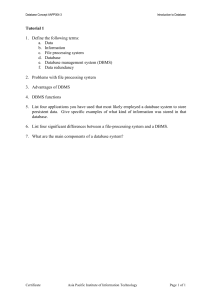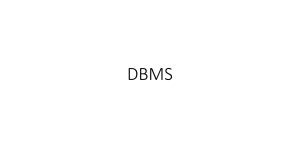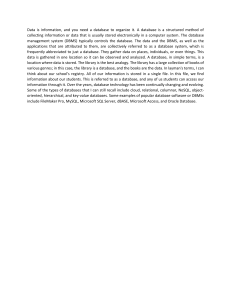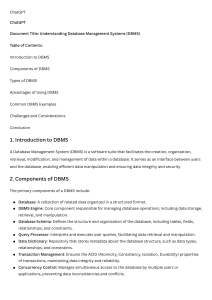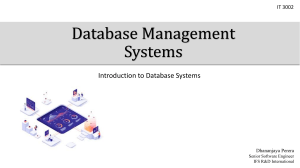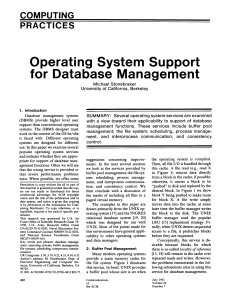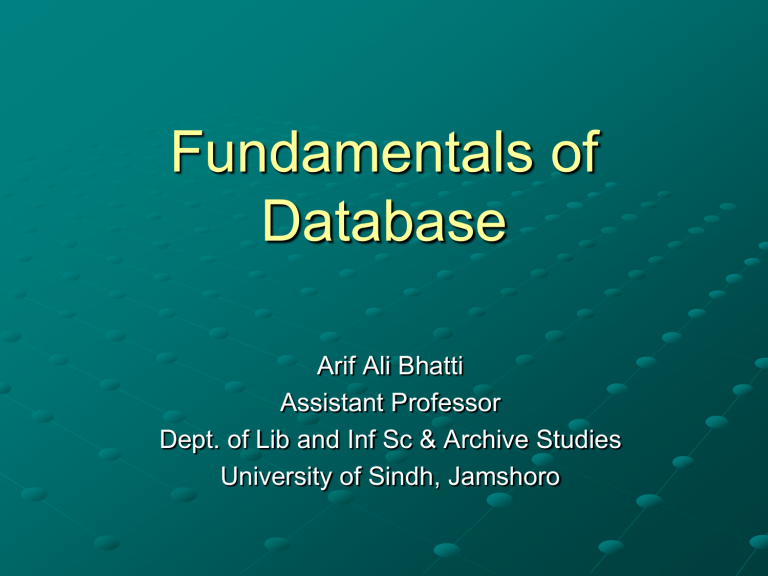
Fundamentals of Database Arif Ali Bhatti Assistant Professor Dept. of Lib and Inf Sc & Archive Studies University of Sindh, Jamshoro What is a database A database is any organized collection of data. Some examples of databases you may encounter in your daily life are: a telephone book T.V. Guide airline reservation system motor vehicle registration records papers in your filing cabinet files on your computer hard drive. General: • A database is any collection of related data. Restrictive: • A database is a persistent, logically coherent collection of inherently meaningful data, relevant to some aspects of the real world. Data vs. information: What is the difference? What is data? Data can be defined in many ways. Information science defines data as unprocessed information. What is information? Information is data that have been organized and communicated in a coherent and meaningful manner. Data is converted into information, and information is converted into knowledge. Knowledge; information evaluated and organized so that it can be used purposefully. Why do we need a database? Keep records of our: Clients Staff Volunteers To keep a record of activities and interventions; Keep sales records; Develop reports; Perform research Longitudinal tracking What is the ultimate purpose of a database management system? Is to transform Data Information Knowledge Action More about database definition What is a database? Quite simply, it’s an organized collection of data. A database management system (DBMS) such as Access, FileMaker, Lotus Notes, Oracle or SQL Server which provides you with the software tools you need to organize that data in a flexible manner. It includes tools to add, modify or delete data from the database, ask questions (or queries) about the data stored in the database and produce reports summarizing selected contents. Database: A Formal Definition A database is an ordered collection of related data elements intended to meet the information needs of an organization and designed to be shared by multiple users. Key terms in the definition: Ordered collection. A database is a collection of data elements. Not just a random assembly of data structures, but a collection of data elements put together deliberately with proper order. The various data elements are linked together in the most logical manner. Related data elements. The data elements in a database are not disjointed structures without any relationships among them. These are related among themselves and also pertinent to the particular organization. Information needs. The collection of data elements in a database is there for a specific purpose. That purpose is to satisfy and meet the information needs of the organization. In a database for a bank, you will find data elements that are pertinent to the bank’s business. You will find customer’s bank balances and ATM transactions. You will not find data elements relating to a student’s major and examination grades that belong in a database for a university. You will not find a patient’s medical history that really belongs in a database for a medical center. Shared. All authorized users in an organization can share the information stored in its database. Integrated information is kept in the database for the purpose of sharing so that all user groups may collaborate and accomplish the organization’s objectives. TYPES OF DATABASES Organizations primarily adopt one of two approaches. If the entire database is kept in one centralized location, this type of database is a centralized database. On the other hand, if fragments of the database are physically placed at various locations, this type of database is a distributed database. Each type has its own benefits and shortcomings. Again, whether an enterprise adopts a centralized or a distributed approach depends on the organizational setup and the information requirements. Let us review the two types. Distributed Database Management System What does “managing information” mean? Making information work for us Making information useful Avoiding "accidental disorganisation” Making information easily accessible and integrated with the rest of our work Managing as re-organising We often need to access and re-sort data for various uses. These may include: Creating mailing lists Writing management reports Generating lists of selected news stories Identifying various client needs Can you add to the list? Managing as re-processing The processing power of a database allows it to: Sort Match Link Aggregate Skip fields Calculate Arrange DBMS Functions Performs functions that guarantee integrity and consistency of data Data dictionary management defines data elements and their relationships Data storage management stores data and related data entry forms, report definitions, etc. Data transformation and presentation translates logical requests into commands to physically locate and retrieve the requested data DBMS Functions (continued) Security management enforces user security and data privacy within database Multi-user access control creates structures that allow multiple users to access the data Backup and recovery management provides backup and data recovery procedures DBMS Functions (continued) Data integrity management promotes and enforces integrity rules to eliminate data integrity problems Database access languages and application programming interfaces provides data access through a query language Database communication interfaces allows database to accept end-user requests within a computer network environment The Database System Environment Database system is composed of 5 main parts: 1. 2. Hardware Software Operating system software DBMS software Application programs and utility software 3. 4. 5. People Procedures Data Basic File Terminology Table A Database with Multiple Tables [1] Publishers Books Customers Authors Inventory Orders Field (Column) Customers a field Record (Row) Customers a record
